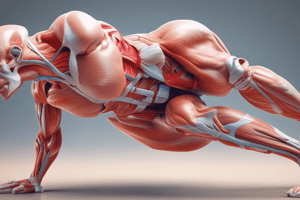Podcast
Questions and Answers
Which muscle group is responsible for stabilizing the pelvis and lumbar spine during lateral flexion?
Which muscle group is responsible for stabilizing the pelvis and lumbar spine during lateral flexion?
- Multifidus
- Psoas Major
- Erector Spinae
- Quadratus Lumborum (correct)
What is a primary function of the multifidus muscle?
What is a primary function of the multifidus muscle?
- Provides stability to the lumbar spine (correct)
- Extends and laterally flexes the spine
- Assists in trunk rotation
- Flexes the hip
Which of the following muscles primarily assists in trunk rotation?
Which of the following muscles primarily assists in trunk rotation?
- Iliocostalis
- Obliques (correct)
- Psoas Major
- Rectus Abdominis
Which condition is commonly associated with overstretching or tearing of lower back muscles?
Which condition is commonly associated with overstretching or tearing of lower back muscles?
How does the erector spinae muscle group function in relation to posture?
How does the erector spinae muscle group function in relation to posture?
What is the primary role of the rectus abdominis in relation to lower back health?
What is the primary role of the rectus abdominis in relation to lower back health?
Which muscle is primarily considered a hip flexor but also contributes to lumbar stabilization?
Which muscle is primarily considered a hip flexor but also contributes to lumbar stabilization?
Which practice is emphasized for injury prevention of lower back muscles?
Which practice is emphasized for injury prevention of lower back muscles?
Flashcards are hidden until you start studying
Study Notes
Overview of Lower Back Muscles
- The lower back, or lumbar region, consists of several key muscle groups that support movement and stability.
Major Muscles
-
Erector Spinae
- Composed of three muscle groups: iliocostalis, longissimus, and spinalis.
- Function: Extends and laterally flexes the spine; crucial for posture.
-
Multifidus
- Deep stabilizing muscle located along the vertebral column.
- Function: Provides stability to the lumbar spine and aids in rotation and extension.
-
Quadratus Lumborum
- Located on either side of the lumbar spine.
- Function: Stabilizes the pelvis and lumbar spine; assists in lateral flexion.
-
Psoas Major
- A major hip flexor that originates from the lumbar vertebrae.
- Function: Flexes the hip and helps stabilize the lumbar spine.
-
Rectus Abdominis
- While primarily a core muscle, it influences the lower back.
- Function: Supports the lumbar spine during bending and lifting.
-
Obliques (External and Internal)
- Located on the sides of the abdomen.
- Function: Assist in trunk rotation and lateral flexion; contribute to core stability.
Functions of Lower Back Muscles
- Stabilization: Provide support to the spine and pelvis during movement.
- Movement: Facilitate bending, twisting, and lifting activities.
- Posture: Maintain an upright position and prevent slouching.
Common Issues
- Strains: Overstretching or tearing of lower back muscles, often due to improper lifting.
- Muscle Imbalances: Weakness in certain muscles can lead to pain and instability.
- Injuries: Chronic pain can result from repetitive stress or acute injuries.
Injury Prevention and Management
- Strengthening Exercises: Focus on core stability and back strength (e.g., planks, deadlifts).
- Flexibility Training: Stretching exercises for the lower back and hips.
- Proper Lifting Techniques: Use legs for lifting to reduce strain on the back.
- Posture Awareness: Maintain good posture to reduce chronic strain on back muscles.
Conclusion
- The lower back muscles play a crucial role in stability, movement, and posture.
- Understanding their functions and how to care for them can help prevent injuries and maintain a healthy back.
Overview of Lower Back Muscles
- Lower back, or lumbar region, consists of key muscle groups crucial for movement and stability.
Major Muscles
- Erector Spinae: Composed of iliocostalis, longissimus, and spinalis; extends and laterally flexes the spine, vital for posture.
- Multifidus: Deep stabilizing muscle along the vertebral column; provides lumbar spine stability and aids in rotation and extension.
- Quadratus Lumborum: Positioned on either side of the lumbar spine; stabilizes pelvis and lumbar region, assists in lateral flexion.
- Psoas Major: Major hip flexor originating from lumbar vertebrae; flexes hip and stabilizes the lumbar spine.
- Rectus Abdominis: Core muscle that supports the lumbar spine during bending and lifting actions.
- Obliques (External and Internal): Located on the abdominal sides; assist in trunk rotation and lateral flexion, contributing to core stability.
Functions of Lower Back Muscles
- Stabilization: Supports spine and pelvis during various movements.
- Movement: Facilitates activities such as bending, twisting, and lifting.
- Posture: Maintains an upright position, preventing slouching.
Common Issues
- Strains: Result from overstretching or tearing of lower back muscles, often due to improper lifting techniques.
- Muscle Imbalances: Weakness in certain muscles can lead to pain and instability in the lower back.
- Injuries: Chronic pain may arise from repetitive stress or acute injuries to lower back muscles.
Injury Prevention and Management
- Strengthening Exercises: Focus on core stability and back strength; include exercises like planks and deadlifts.
- Flexibility Training: Incorporate stretching exercises for the lower back and hips to enhance flexibility.
- Proper Lifting Techniques: Emphasize the use of legs for lifting to minimize strain on the back.
- Posture Awareness: Encourage good posture practices to mitigate chronic strain on back muscles.
Conclusion
- Lower back muscles are essential for stability, movement, and posture; understanding their functions and care is key to preventing injuries and promoting back health.
Studying That Suits You
Use AI to generate personalized quizzes and flashcards to suit your learning preferences.



